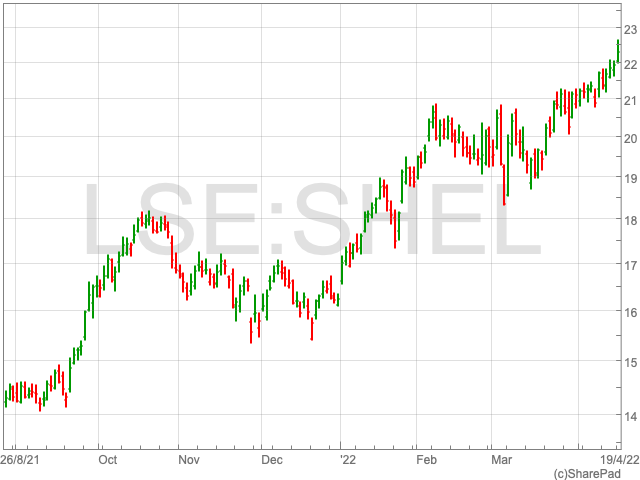Shell shares have enjoyed solid gains over the past 12 months with macro-economic pressures providing an ideal environment for earnings growth.
Since February 2022, sanctions and bans on Russian oil supply along have provided energy stocks with higher oil prices and expectations of higher earnings. This was a welcome relief to oil firms after the pandemics latest strain, Omicron, resulted in lockdowns across the globe and halts in production hurting oil prices, and in turn hurting Shell.
However, the oil and gas company’s shares have gained 31% year-to-date as curbs on oil imports from the world’s second-largest exporter, Russia, caused inflationary pressures which boosted the price of oil across the globe.
Shell has the largest market capitalisation on the FTSE 100 with a market cap of £168bn as of Tuesday. The Shell share price six month low was 1,556p in late November 2021. However, since then the Shell shares have consistently produced respectable gains.



Shell Recent History
September
Before September 2021, Shell shares were moving with relative steadiness. However, a series of events have helped boost the Shell share price higher over the last 6 months.
Shell began its upward climb in mid-September 2021 when the company announced the construction of a biofuels facility at its site in Rotterdam.
The facility in Rotterdam was amongst the largest of its type in Europe and was located at Shell Energy & Chemicals Park Rotterdam, formerly known as the Pernis refinery.
The facility is capable of producing 820,000 tonnes per year of sustainable aviation fuel and diesel from waste, where aviation fuel is expected to produce more than half the output capacity of the facility.
In late September, the company announced its West Delta-143 facility in the Gulf of Mexico suffered “significant structural damage” due to Hurricane Ida, with parts of it offline until the end of the year.
West Delta-143 is a transfer station for production from Shell’s assets in the Mars corridor in the Mississippi Canyon area of the Gulf of Mexico to onshore crude terminals.
During the same period, Shell announced the sale of its assets in the Permian Basin of the US to rival ConocoPhillips for $9.5bn. The proceeds from the sale would be used towards a $7bn payout to shareholders and strengthen its finances which gave the shares of the company a boost.
Amongst disposals, the company’s subsidiaries also completed the sale of upstream assets from Shell Egypt NV and Shell Austria GmbH in Egypt’s the Western Desert to Capricorn Egypt and subsidiaries of Cheiron Petroleum for 50% each.
Overall, in September, despite losses created through hurricane damage in the US, the company’s disposal of assets helped the group’s overall share price performance, and stock kicked off what would be a sustained uptrend.
October
October disclosed Q3 results for the company which included the damages caused by Hurricane Ida on the group’s assets in the Gulf of Mexico. The damages amounted to £400m and were expected to hurt Shell’s earnings in Q3 2021.
Shell expected the Upstream segment to take the biggest hit, with adjusted earnings to fall by $200m-$300m. Production in the Upstream segment is expected to see a 4.7% decline to 2m- 2.1m barrels of oil equivalent per day (BPD) in the third quarter.
The group expects Oil Products to be lowered by $50m-$100m and Chemicals to take a $100m hit.
In mid-October, Brent Crude reached $84 a barrel for the first time in 3 years lifting oil stocks including Shell.
Shell released its Q3 results in late October where the company reported a loss attributable to shareholders of $447m compared to a profit of $489m in 2020 due to pressure from activist investors.
The oil and gas company saw a decline of 200,000 BPD from Q2 2021 to 3.1m BPD in the third quarter. However, Shell pledged additional returns to shareholders following the sale of its Permian Basin assets amounting to $7bn which restored investor faith in the shares.
November
Shell shares were steady through the first couple of weeks in November despite the company announcing the re-commencement of operations at its Maras and Ursa platforms in the US Gulf of Mexico and had started exporting oil and gas through the West Delta-143 A facility.
The company also announced that 100% of the Shell-operated output in the Gulf of Mexico will resume online before expectations once Mars and Ursa are producing optimally.
Around mid-November, Shell announced that it plans to simplify its share structure and change its name to Shell PLC from Royal Dutch Shell. Instead of the ‘A’ and ‘B’ share structure, the company planned for a conventional single share structure to allow for an ‘acceleration in distributions by way of share buybacks, reduce the risk for shareholders, and let the company manage its portfolio with greater flexibility’.
Shell announced its plan to acquire online energy retailer Powershop Australia in late November to form Shell’s residential power platform in Australia.
December
Shell shares began to rise again from the start of December 2021 with its first announcement for the month being the completion of the sale of its assets in Permian to ConocoPhillips for $9.5bn in cash.
The company commenced the first tranche of share buybacks following the sale of its Permian business, coming up to $1.5bn right after the sale was completed which were later cancelled. This buyback is part of the $7bn shareholder distributions pledged by the company in September.
Plans to move to London for the corporation were set around mid-December followed by the company announcing the acquisition of Savion.
Amongst other expansion strategies, the company faced contract renewals and extensions around late December with companies such as Smart Metering Systems. The company also signed an agreement with the government of Oman for gas production at the Saih Rawl field.
In December, the company also pulled out of its plan to develop the Cambo oilfield in the North Sea near the Shetland Isles due to criticism from activists leading to investors becoming worried. However, the company does rethink this move later on in 2022.
Adding to news that may upset investors, a South African court banned Shell from conducting energy exploration using seismic waves of a touristic stretch of coastline.
Year to Date
The start of 2022 was still dealing with the pandemic which hurt manufacturers worldwide as lockdowns were implemented to curb the widespread Omircon variant along with supply issues impacting oil prices.
Adding to the debacle of 2022 was the Russian invasion of Ukraine which played the largest role in the volatility that Shell shares have seen this year.
Shell began the year with a confirmation on continuing the share buyback programme “at pace”, despite seeing a slight hit on oil products demand due to the Omicron variant.
During the end of January, Shell started operations of its first hydrogen electrolyser in China through its joint venture with Zhangjiakou City Transport Construction Investment Holding Group. The group ended the month by finally unifying its shares.
The second month of 2022 saw the start of the war and Shell reported its Q4 2021 results along with its final report.
Shell’s Q4 Results
Shell’s total revenue in Q4 2021 more than doubled to $90bn, up from $45bn the previous quarter. However, for the full year of 2021, revenue climbed 49% to $272.7bn compared to $183.2bn in 2020.
Shell had a $29.8bn pretax profit in 2020, compared to a $267bn loss in a Covid-affected 2020. Pretax earnings increased from $1.2bn to $16.3bn in the fourth quarter.
The company’s adjusted earnings in Q4 increased to $6.4bn, up from $393m in 2020. Shell’s Integrated Gas division drove the increase, which was up 55% from $4.1 in the previous quarter. Adjusted earnings for the year surpassed the market consensus of $18bn, up dramatically from $4.9bn in 2020.
Average liquid prices rose to $77.75 a barrel in Q4, up from $68.04 a barrel in Q3, boosting the Integrated Gas, Renewables & Energy Solutions unit.
Shell also increased its annual dividend by 37%, from $0.6530 per share in 2020 to $0.8935 per share in 2021. The company’s Q1 2022 dividend will be increased to $0.25 per share, up from $0.24 in Q4 2021.
Meanwhile, Q4 output was a bit of a mixed bag. Production of integrated gas declined to 927,000 BPD in the fourth quarter, down from 938,000 in Q3. The first quarter of 2022 is expected to produce between 760,000 and 820,000 BPD.
Upstream output increased by a quarter to 2.16m BPD, up from 2.08m Q3 figures. The range for the first quarter is between 2m and 2.2m.
Russian Invasion Impact on Shell
Russia invaded Ukraine in late February which led to companies breaking off association with Russia as the West began to focus on stopping Putin through sanctions.
Withdrawal from PJSC Gazprom
Following Russia’s invasion of Ukraine, Shell said that it will withdraw its joint ventures with Russian energy major PJSC Gazprom, as well as its involvement with the Nord Stream 2 pipeline project.
Shell will sell its 28% ownership in the Sakhalin-II liquefied natural gas facility, its 50% stake in Salym Petroleum Development NV, and its 50% stake in the Gydan energy venture, among other things.
The Salym JV is focused on the development of the Salym fields in western Siberia’s Khanty Mansiysk Autonomous District, while Gydan is a joint venture between Gazprom and Shell for the exploration and development of a block in northwestern Siberia’s Gydan peninsula.
Shell was also one of five energy companies that agreed to offer funding and guarantees for up to 10% of the estimated cost of Nord Stream 2.
Shell exits Russia
In March, Shell said that it will exit all Russian hydrocarbons, including crude oil, petroleum products, gas, and liquefied natural gas through “phases”.
Shell had announced that it will stop buying Russian crude on the spot market and close its service stations, aviation fuels, and lubricants activities in Russia.x
Following the invasion of Ukraine, the UK business also apologised for purchasing a cargo of Russian oil which gave hope to ethical investors.
In April, the company released a statement stating a $5bn loss from its withdrawal from Russia. However, Shell reassured investors that overall earnings for the year will have no impact as investments withdrawn from Russia will be allocated elsewhere.
Shell’s YTD Acquisitions, Deals and Disposals
In early January, Shell and Iberdrola SA’s ScottishPower joint venture won multiple bids to develop 5 gigawatts of floating wind power in Scotland as part of Crown Estate Scotland’s ScotWind Leasing bidding process.
In late January, Shell sold its 50% interest in Deer Park Refining Partnership for $596m, in a combination of debt and cash.
At the end of March, the company began production at subsea development PowerNap which is located in the US Gulf of Mexico. The development is expected to produce 20,000 BPD at its peak. The company also obtained an extension to its license on the Cambo oilfields from the UK government.
Shell Share Price Valuation
Shell has a market capitalization of £168bn and its shares have gained 31% YTD.
In the last 6 months, Shell shares have increased 25% with the stock seeing a 2% rise to 2,232p on Tuesday.
Shell has a forward P/E of 6x with a trailing P/E of 14.2x and a ROCE of 8.6x.
The company has a dividend yield of 3.1x and a cover of 2.3x which may mean better dividends for investors in the future can be expected.
Shell’s Outlook
Shell is well spread across the globe to withstand Russia’s sanctions and the problems it caused for the company.
With the Shell share price on the rise since the start of 2022, it’s easy to think that investors who are yet to buy Shell have missed the boat. However, with the booming commodities market and possibility of higher dividends in the future, investors may have scope for decent returns in the near future with an allocation to Shell shares.





